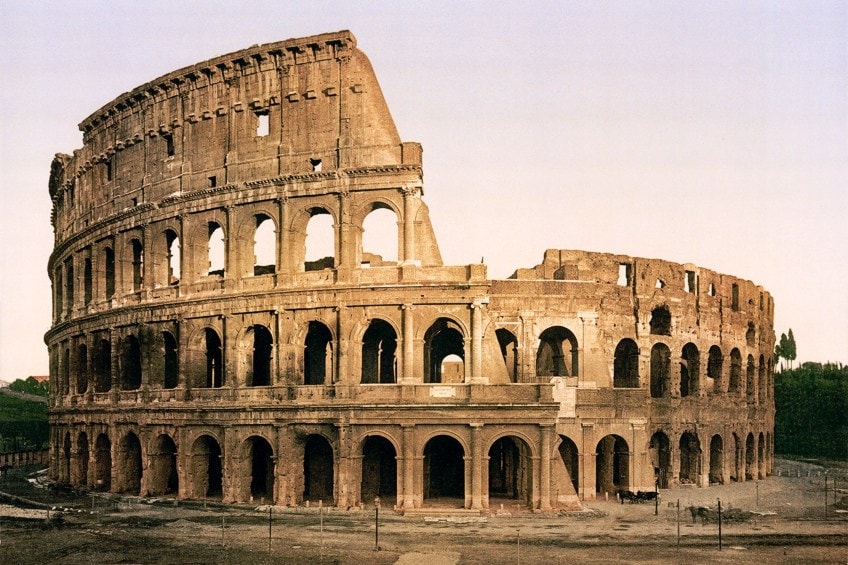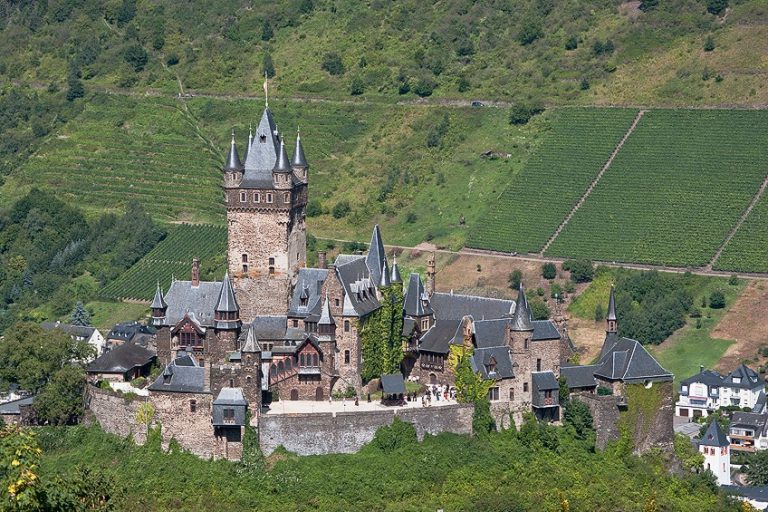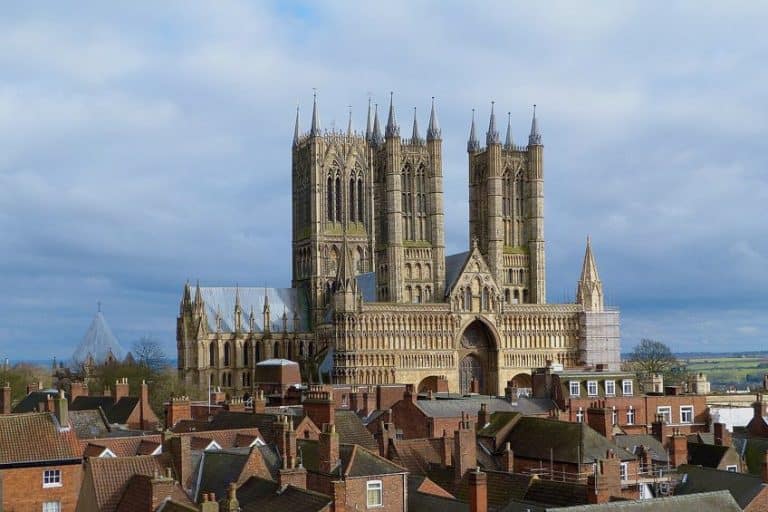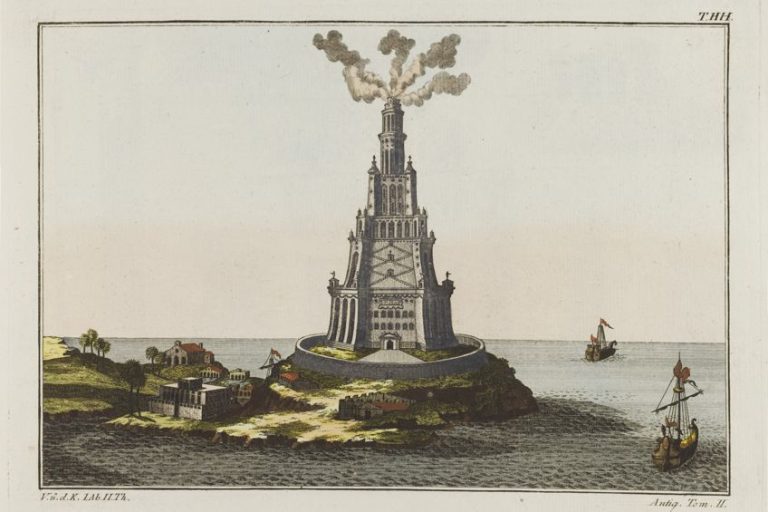Roman Colosseum – Looking at the Roman Colosseum’s History
The Roman Colosseum is one of the most recognized monuments in the history of mankind. The original Roman Colosseum’s name was Amphitheatrum, although, in recent Colosseum history, it has been commonly referred to as the Flavian Amphitheater. When was the Colosseum built, what was the Colosseum used for, and what is the Roman Colosseum made of? We will be answering such questions as well as exploring many interesting Roman Colosseum facts in this article.
Exploring the Roman Colosseum
The original Roman Colosseum’s name eventually changed to the Flavian Amphitheater as it became associated with the Flavian dynasty – the patrons who built the Colosseum in Rome. But how long was the Colosseum used for, what was the colosseum used for, and what is the Colosseum used for today? Let us investigate those questions and discover many other fascinating Roman Colosseum facts.
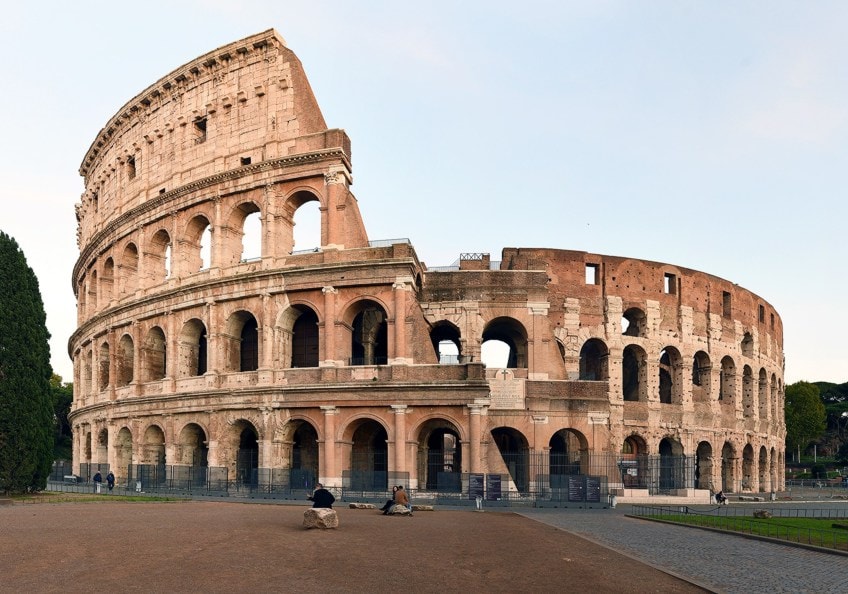
The Original Roman Colosseum History
Exactly when was the Roman Colosseum built? The large amphitheater famously known as the Colosseum, located immediately east of the Roman Forum, was constructed as a tribute to the People of Rome by Emperor Vespasian of the Flavian dynasty approximately around 70 AD.
The original Roman Colosseum was used for communal events including simulated naval warfare, game hunts, reenactments of great wars, gladiatorial fights, and plays centered around Classical mythology.
In the early medieval period, the structure stopped being utilized for entertainment. Subsequently, it was utilized again for things like residences, workshop spaces, religious order lodgings, a castle, a reservoir, and a Christian sanctuary.
Construction of the Colosseum
The location was a level region at the bottom of a small valley between the Esquiline, Caelian, and Palatine Hills. The valley also had an artificial lake and a canalized stream. The region was intensively populated by the second century BC. Following the Great Fire of Rome in 64 AD, which completely destroyed it, Nero took a large portion of the region to expand his own realm.
On the spot, he constructed the opulent Domus Aurea, which was encircled by man-made lakes, porticoes, lawns, and pavilions. Water was brought into the region by the Aqua Claudia aqueduct, and the enormous bronze Colossus of Nero was erected close by at the Domus Aurea entrance.

The Colossus was intact, although the Domus Aurea was mostly destroyed. The site was utilized to build the rebuilt Flavian Amphitheatre once the lake was packed in. Within the old grounds of the Domus Aurea, gladiatorial academies and other auxiliary structures were built. Vespasian’s choice to construct the Colosseum on the location of Nero’s lake might be interpreted as a patriotic effort to restore to the public a section of the city that Nero had taken for himself.
In contrast to many other amphitheaters, the Colosseum was erected in the city center, thereby positioning it both symbolically and practically at the hub of Rome.
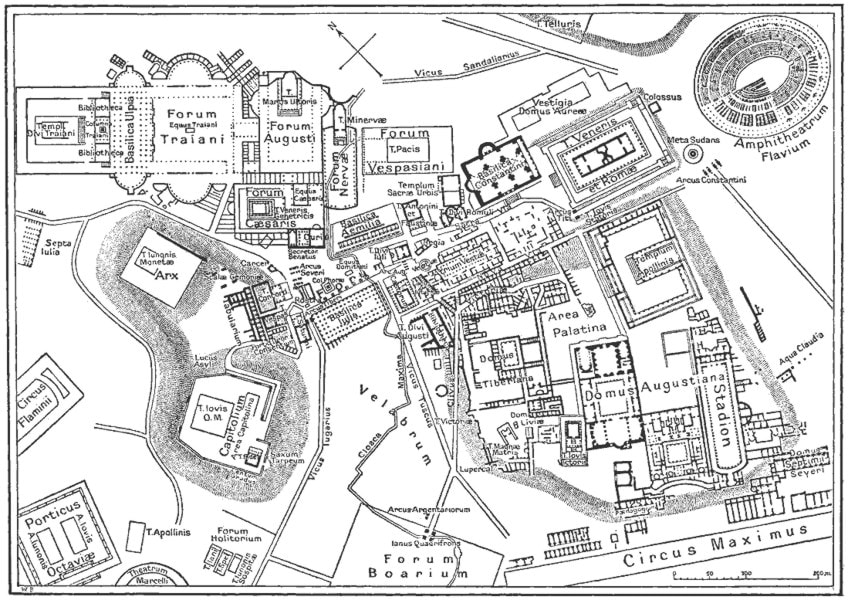
The lavish treasures plundered from the Jewish Temple during the Siege of Jerusalem in 70 AD were used to pay for construction. “The emperor commanded this new amphitheater to be created with his general’s share of the spoils,” according to a restored plaque discovered on the site. There is no historical proof that Jewish captured soldiers were taken back to Rome and contributed to the vast manpower required for the development of the amphitheater, although it would be consistent with Roman practice to humiliate the vanquished populace.
To answer the question of who built the Colosseum in Rome: teams of expert Roman constructors, designers, painters, artists, and decorators also took on the more specific jobs required to construct the Colosseum in addition to this cheap supply of unskilled labor.
And what is the Roman Colosseum made of? A range of different materials, namely limestone, wood, tuff, cement, mortar, and tiles were used in the construction of the Colosseum.
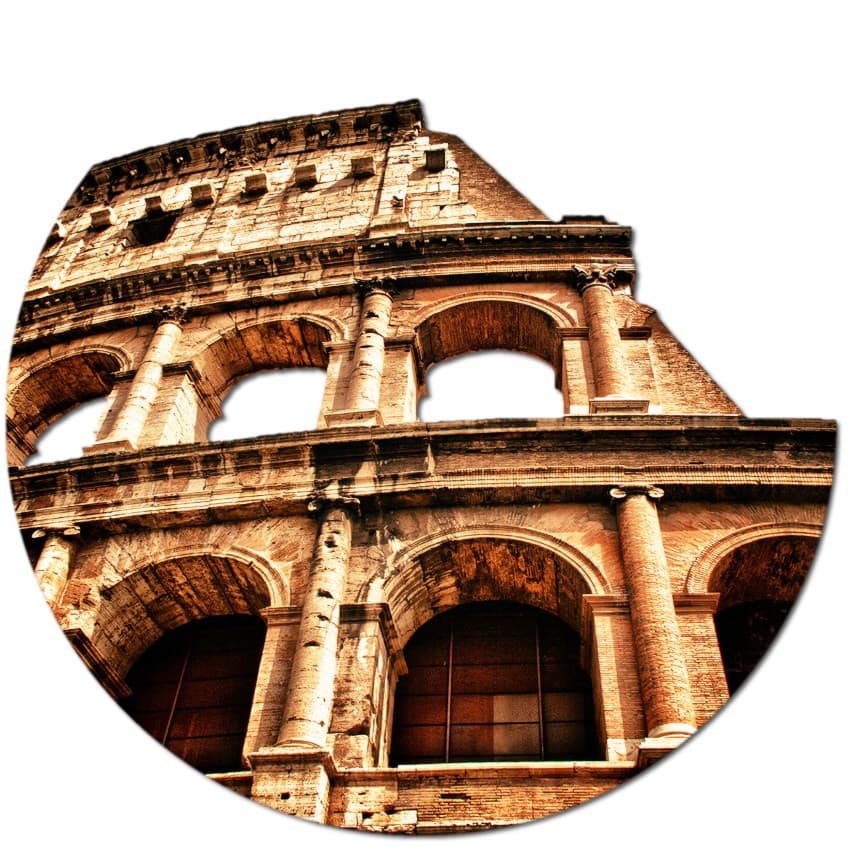
When was the Roman Colosseum built? Under Vespasia’s leadership, the Colosseum’s construction got underway around 70 AD. Vespasian died in 79, and the Colosseum was finished up to the third story at that time.
His son Titus completed the top level in 80 AD, and the first games were conducted in 80 or 81 AD.
Over 9,000 animals were reportedly murdered at the opening ceremonies of the amphitheater, according to Dio Cassius. Coinage commemorating the inauguration was released. The structure underwent significant renovations under Vespasian’s youngest son, the newly crowned Emperor Domitian, who built the hypogeum, a network of tunnels intended to hold slaves and animals. To significantly increase the seating capacity in the Colosseum, he also built a gallery on top of it.
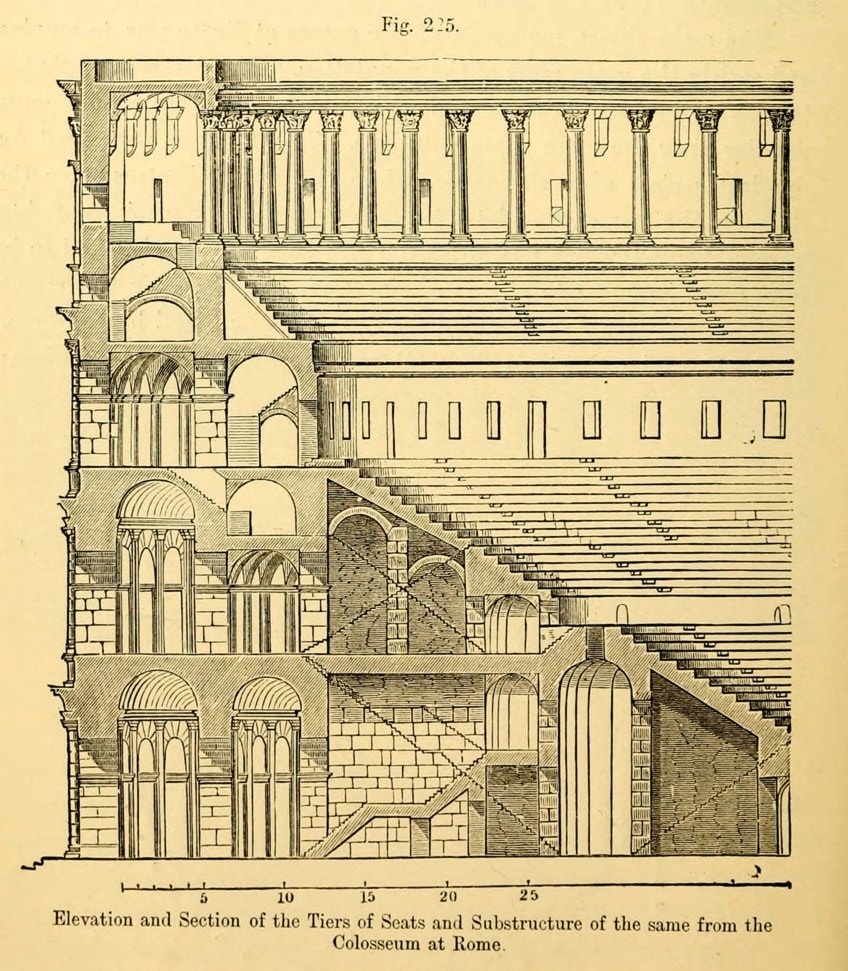
The wooden top floors of the Colosseum’s interior were completely destroyed by a large fire in 217 that severely damaged the structure. According to Dio Cassius, the fire was started by lightning. It wasn’t completely fixed until around 240, and then it needed more work in 250 or 252 and again in 320. In 399 and again in 404, Honorius outlawed the practice of gladiatorial combat.
The last time gladiatorial combat is described is around 435.
An inscription describes the Colosseum’s reconstruction in several areas during the reigns of Theodosius II and Valentinian III, probably to repair harm from a significant earthquake in 443; more work was done in 484 and 508 after that. Even until the sixth century, the arena was still being utilized for competitions.
The Medieval Use of the Roman Colosseum
The Colosseum’s use changed dramatically multiple times. A small chapel had been built inside the amphitheater by the late sixth century, however, it didn’t seem that this gave the structure any more religious significance. A cemetery had been created within the arena. The various vaulted areas under the sitting in the arcades were turned into apartments and workplaces and were being leased out as recently as the 12th century.
The Colosseum reportedly underwent reinforcement in 1200 and was used as a stronghold by the Frangipani dynasty.
The Colosseum sustained significant damage during the great earthquake of 1349, causing the outer south side to collapse since it was constructed on less stable alluvial terrain. A large portion of the crumbling stone was reused to build palaces, churches, hospitals, and other buildings all across Rome. A monastic order moved into the northern section of the Colosseum in the middle of the 14th century, and they stayed there until the early 19th century. The inside of the amphitheater was severely stripped of stone, which was either reused elsewhere or burnt to generate quicklime. The iron clamps that kept the stones together were pulled or cut out of the walls, creating many pockmarks that are still visible today.

Modern Use and Restoration
Church officials sought a beneficial function for the Colosseum in the 16th and 17th centuries. Pope Sixtus V intended to convert the structure into a wool factory to offer jobs to Rome’s prostitutes, but his untimely death prevented this from happening. Cardinal Altieri allowed its usage for bullfights in 1671, but the proposal was quickly abandoned due to popular uproar. Pope Benedict XIV agreed in 1749 that the Colosseum was a hallowed spot where early Christians were killed. He prohibited the Colosseum from being used as a quarry and dedicated it to the Passion of Christ, installing Stations of the Cross and pronouncing it holy by the blood of the Christian warriors who died there.
Benedict’s assertion, however, is not supported by any historical evidence, and there is also no proof that anybody before the 16th century even proposed that this might be the case.
According to the Catholic Encyclopedia, the only historical support for the hypothesis is the conceivably plausible theory that some of the numerous martyrs were. Later popes started a variety of stabilizing and conservation operations, clearing the building’s enormous vegetation that had overtaken it and posed a threat to further harm it. In 1807 and 1827, brick wedges were added to the façade, and in 1831, and the 1930s, the interior was restored. Under Benito Mussolini in the 1930s, the arena’s foundation was entirely exposed after only partial excavation in 1810 and 1874.
With millions of tourists each year, the Colosseum is currently one of Rome’s most well-liked tourist destinations. Significant repair work was carried out between 1993 and 2000 as a result of the impacts of pollution and general degradation over time. Since it was abolished in Italy in 1948, the Colosseum has come to represent the global movement against the death penalty. In 2000, there were a number of anti-death penalty protests held in front of the Colosseum.
Since then, whenever a person sentenced to death anywhere else in the world has their punishment converted or is cleared, or when a court eradicates capital punishment, the city officials in Rome have changed the color of the Colosseum’s late evening lighting from white to gold as a protest against capital punishment.
Physical Description of the Roman Colosseum
The Colosseum is a completely free-standing edifice, in contrast to Roman theaters that were carved into hillsides. Its fundamental external and internal architecture is modeled by that of two theaters placed side by side. A 5-meter-high wall surrounds the oval-shaped core arena, which is 87 meters long and has layers of seating rising above it.
Exterior Description
Over 100,000 cubic meters of travertine stone, laid without cement and joined by 300 tons of iron clamps, are said to have been needed for the exterior wall. Nevertheless, it has sustained significant damage over the years, with significant sections collapsing after earthquakes. The characteristic triangle brick wedges at either end of the remaining north side of the outer wall are new additions that were built in the early 19th century to strengthen the wall.
The original inside wall makes up the remaining portion of the Colosseum’s façade today.
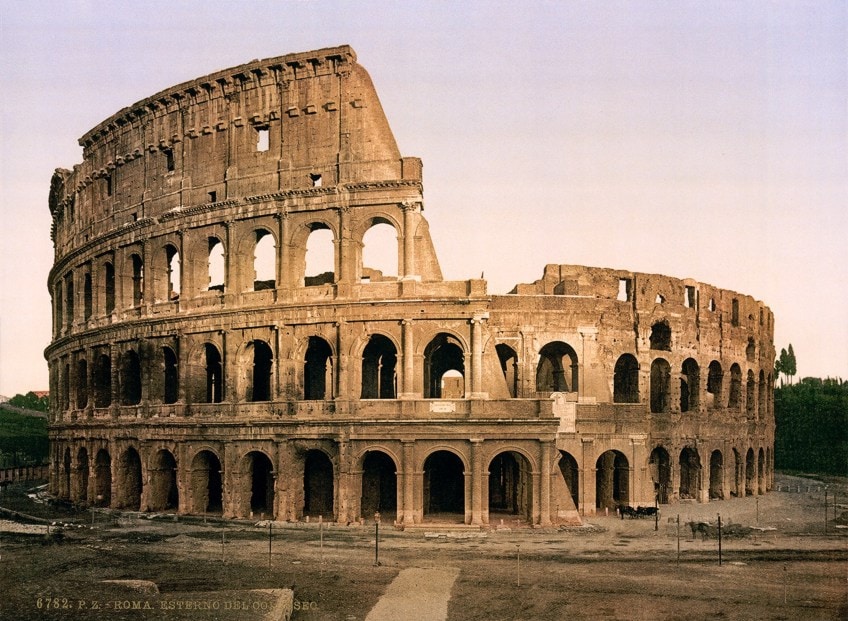
The monumental façade of the outer wall’s remaining portion is made up of three superimposed stories, a platform, and a lofty attic, all of which are punctured by windows spaced regularly throughout. Ionic, Doric, and Corinthian half-columns of various orders border the arcades, while Corinthian pilasters adorn the attic. The statues that were framed by each arch in the second-and third-floor arcades are most likely meant to commemorate gods and other characters from classical mythology. A total of 240 mast corbels were placed around the attic’s peak.
Originally, they held up the velarium, a retractable canopy that shielded spectators from the sun and rain. This was constructed using ropes to form a net-like structure that was covered in canvas and had a hole in the center.
It encompassed two-thirds of the stadium and slopped down toward the center to receive the wind and provide air circulation for the spectators. The velarium was staffed by sailors who had been carefully recruited from the adjacent Castra Misenatium and the Roman naval headquarters at Misenum.
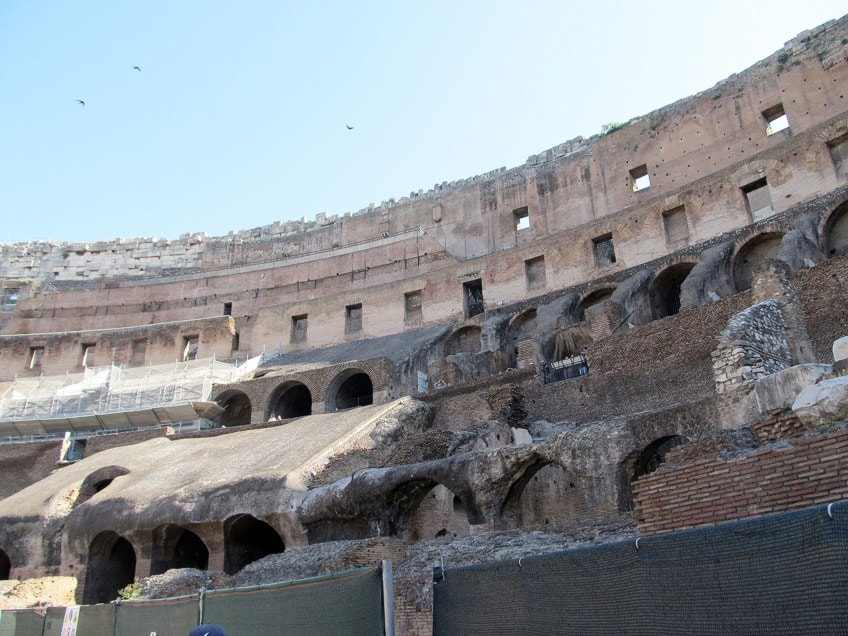
The Colosseum’s enormous seating capacity made it crucial that the area could be swiftly filled or cleared. To address the same issue, its builders developed strategies that are remarkably similar to those used in contemporary stadiums. Eighty ground-level entrances surrounded the amphitheater, 76 of which were utilized by regular spectators. Each staircase had a number, as did each entry and exit.
The northern gate was used by the Roman Emperor and his advisors, while the nobility most likely entered by the three axial approaches.
All four axial entrances were lavishly embellished with decorated stucco reliefs, parts of which exist. With the fall of the perimeter wall, several of the old exterior entrances vanished. Spectators were handed numbered ceramic shard tickets that led them to the correct section and row. They got to their seats through vomitoria, which were corridors that led onto a layer of seats from underneath or behind. These swiftly distributed people into their seats and, at the end of the event or during an emergency evacuation, could allow their escape in a matter of minutes.

Interior Description
The Colosseum could hold 87,000 people, although current estimates place the total closer to 50,000. They sat in tiers, reflecting the strictly stratified aspect of Roman society. The emperor was given special seats at the northern and southern ends of the arena, affording the greatest view of the arena. A large platform or podium flanked them on the same level as the roman senate, who were permitted to bring their own seats.
Some fifth-century senators’ names are still visible cut into the masonry, probably reserving places for their usage.
The layer above the senators was held by the non-senatorial aristocratic class or knights. The level above was once designated for regular Roman citizens and was separated into two groups. The bottom section was for affluent residents, and the top section was for impoverished citizens. Other social groups had their own sections, such as boys with instructors, warriors on leave, visiting diplomats, writers, heralds, clergy, and so on. Stone sitting was provided for the inhabitants and nobility, who would have probably brought their own cushions. Inscriptions marked the spaces designated for certain groups.
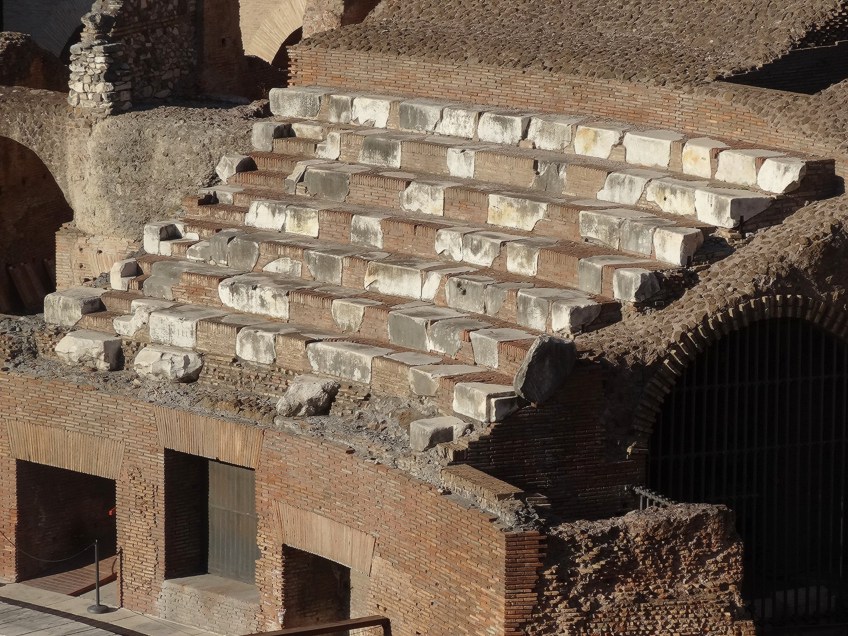
During Domitian’s reign, another level was constructed to the very top of the edifice. This included a gallery for the poor, slaves, and women. It would have either been standing space only or very stiff wooden seats.
Some groups were barred from entering the Colosseum entirely, including gravediggers, playwrights, and retired gladiators.
Each tier was separated into portions by curving tunnels and low walls, which were further broken into portions by the vomitoria’s stairs and aisles. Each row of chairs was numbered, allowing each unique seat to be precisely identified by its number.

The Hypogeum and the Arena
The arena had a sand-covered hardwood floor that covered an extensive subterranean construction called the hypogeum. Emperor Domitian authorized the building of the hypogeum, which was not part of the original design. Little of the original Roman Colosseum arena floor survives, although the hypogeum is still plainly evident.
It was a two-level underground system of tunnels and cages underneath the stadium where gladiators and beasts were confined prior to competitions.
Around 80 vertical tunnels offered fast accessibility to the arena for captive animals and scenic pieces hidden beneath; wider hinged platforms allowed elephants and other large animals to enter. It has been reconstructed several times, with at least 12 separate building periods visible.
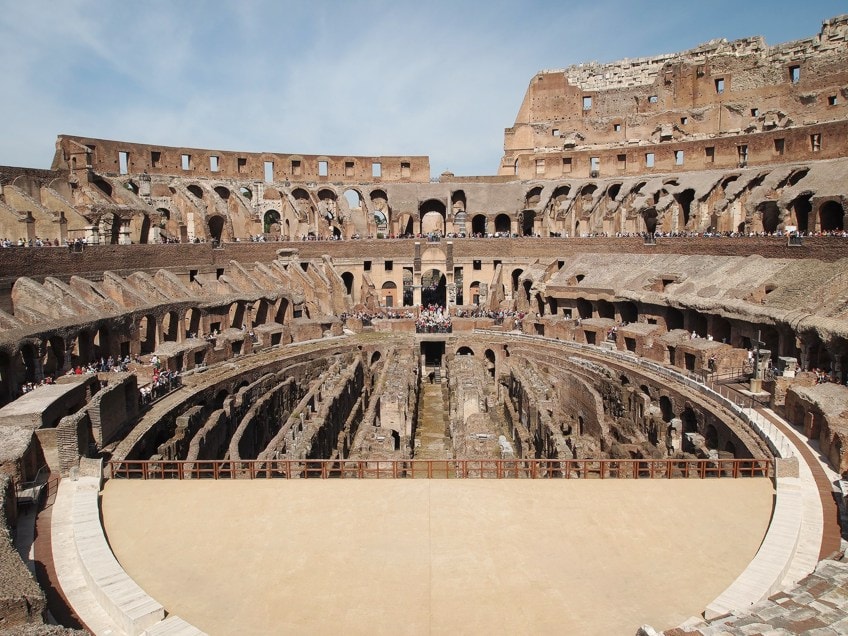
Tunnels linked the hypogeum to a multitude of locations outside the Colosseum. Animals and entertainers were transported down the tunnel from adjacent stables, and tunnels joined the gladiators’ dormitories at the Ludus Magnus to the east. Dedicated tunnels were built for the emperor to enter and depart the Colosseum without having to fight their way through the masses. The hypogeum also housed a substantial amount of machinery.
Lifts and pulleys were used to hoist and drop décor and props, as well as to transport confined animals to the level for release. Major hydraulic systems are known to have existed, and according to historical records, it was feasible to quickly flood the arena, most likely by connecting to a nearby aqueduct.
Early on in the Colosseum’s history, Domitian ordered the building of the hypogeum, which put an end to flooding practices and, in turn, naval fights.
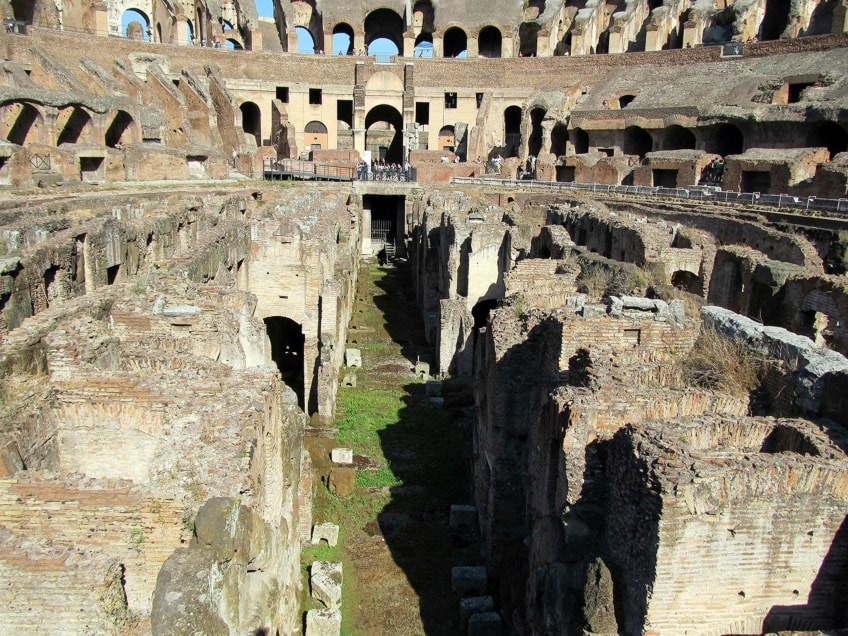
Affiliated Structures
A sizable industry in the region was supported by the Colosseum and its operations. Aside from the amphitheater itself, a lot of other surrounding structures had anything to do with the games. Directly to the east are the remnants of the Ludus Magnus, a school for gladiators. For the gladiators’ convenience, this was attached to the Colosseum via an underground corridor. A small training arena that belonged to the Ludus Magnus was a favorite destination for Roman spectators. The Ludus Matutinus, where animal warriors were trained, as well as the Gallic and Dacian Schools, were located nearby.
Also nearby were the Sanitarium, which featured facilities for treating injured gladiators; the Armamentarium, which included an inventory to store weapons; the Summum Choragium, where equipment was kept; and the Spoliarium, where the remains of deceased warriors were disrobed and disposed of. A row of towering stone posts, with five still standing on the eastern side, surrounded the Colosseum’s circumference at a distance of 18 meters.
They may have served as a religious border, an outside limit for ticket checks, an anchor for the velarium, or an awning, among other possible explanations for their appearance.

Use of the Roman Colosseum
Gladiatorial competitions as well as a range of other events were held in the Colosseum. The performances were never provided by the government but by private groups. They were extremely well-liked by the populace, had a significant religious component, and served as displays of family grandeur and authority. The animal hunt, or venatio, was a different kind of well-liked spectacle.
The animals used for this included hippopotamuses, rhinoceroses, elephants, aurochs, giraffes, wisents, lions, leopards, panthers, bears, Caspian tigers, ostriches, and crocodiles. The majority of the wild animals used for this were acquired from Africa and the Middle East.

Intricate sets with moveable trees and buildings were frequently used to stage battles and hunts. The celebration of Trajan’s conquests in Dacia in 107 reportedly included competitions involving around 11,000 animals and approximatyely10,000 warriors over the length of 123 days. Such festivals were occasionally quite large-scale. Executions would take place between meals. Those who had been found guilty of a crime would be led into the arena, undressed and defenseless, where they would be devoured by the creatures of death. Acrobats and magicians would often put on other shows, usually during the breaks.
Ancient authors said that the Colosseum was once utilized for mock sea battles in its early years.
It was filled with water for a spectacle of swimming mares and bulls that had undergone special training, according to accounts of Titus’ first games in AD 80. A great maritime war between the Corcyrean Greeks and the Corinthians is also described as being re-enacted. The ability to provide water would not have been an issue, but it is not apparent how the stadium could have been water resistant or if there would have been enough room within for the battleships to maneuver. This has generated considerable discussion among historians.
It has been hypothesized that the accounts are either inaccurate with regard to the position or that the Colosseum once had a large floodable canal running through its middle. The arena also hosted recreations of nature settings. Real trees and shrubs would be put on the arena’s floor by painters, technologists, and architects to simulate a forest; after that, animals would be added. Such sceneries may be utilized as the setting for hunts or dramas retelling mythological events, or they could be used to simply show a natural environment for the urban populace.
Modern Use of the Roman Colosseum
What is the Colosseum used for in modern times? Today, the Colosseum is a popular tourist destination in Rome, drawing thousands of visitors each year to see the inside arena. The top story of the structure’s outside wall is currently home to an Eros-themed museum. A portion of the arena’s floor has new flooring. A system of underground corridors that were previously used to carry animals and gladiators to the arena was made public beneath the Colosseum in the summer of 2010.
Roman Catholic rites have also been held at the Colosseum in the 20th and 21st centuries. For example, on Good Friday in the Colosseum, Pope Benedict XVI presided over the Stations of the Cross.
Further Restoration
Diego Della Valle and local authorities came to an agreement in 2011 to support a €25 million renovation of the Colosseum. The project was meant to start at the end of 2011 and last for up to 2.5 years. Work on the repair wasn’t started until 2013 because of the controversy surrounding the use of a public collaboration to pay for it. The restoration marks the Colosseum’s first comprehensive cleaning and repair in history. The Colosseum’s arcaded façade needs to be cleaned and restored, and the metal barriers that obstruct the ground-level arches need to be replaced.
The work took three years to complete, and on the 1st of July, 2016, Dario Franceschini, Italy’s minister of culture, stated that money had been committed to replacing the flooring by the end of 2018. These will offer a platform for “culture events of the greatest level,” according to Franceschini. The proposal also included renovating the Colosseum’s underground chambers and galleries as well as building a services center. The upper two levels have been available for guided tours from November 1st, 2017.
The marketplace was located on the fourth level, and the upper fifth level was where the plebeians, the poorest inhabitants, congregated to see the performance while carrying picnics for the all-day festivity.
Religious Significance of the Roman Colosseum
The Colosseum is frequently associated by Christians with the martyrdom of numerous Christians during their persecution in the Roman Empire, according to religious tradition. Other academics, however, contend that the bulk of martyrdoms may have taken place elsewhere in Rome than in the Colosseum due to a dearth of archival or material proof that is still intact.
Some Christians, according to some academics, were put to death like ordinary criminals in the Colosseum for their crime of refusing to respect the Roman gods, but the majority of Christian martyrs in the fledgling Church were put to death at the Circus Maximus for their beliefs.
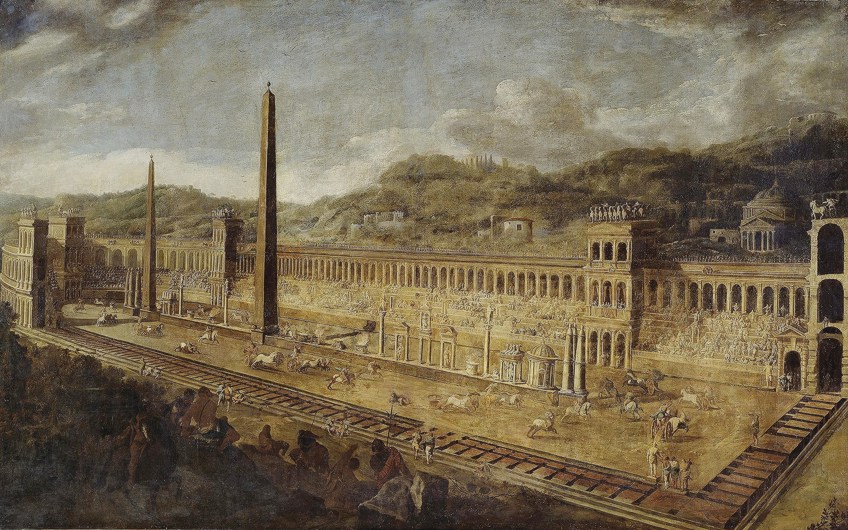
The Colosseum was not considered a monument throughout the Middle Ages and was instead utilized as what some modern sources refer to as a “quarry,” which means that rocks from the Colosseum were removed to create other religious structures. This statistic is claimed to prove that the Colosseum was not recognized as a sacred site during a period when martyr sites were greatly revered. The Colosseum was not mentioned in pilgrims’ itineraries or in writings from the 12th century like the Mirabilia Urbis Romae, which attributes martyrdoms to the Circus Flaminius rather than the Colosseum.
That concludes our look at some of the most significant Roman Colosseum facts. Roman Colosseum history goes back many years and has seen the function of the structure change from era to era. The majestic arena was in constant use for four centuries before it fell into disrepair and was utilized as a supply of building materials until the 18th century. Although two-thirds of the original Colosseum were demolished over time, the amphitheater continues to be a well-liked tourist site and a representation of Rome and its turbulent, protracted past.
Frequently Asked Questions
How Long Was the Colosseum Used For?
The Colosseum amphitheater was erected during the reign of the Flavian emperors. The Colosseum has been used for many various things over the years. It has been utilized used for many purposes since its construction until today. The Colosseum was left in ruins after the fall of the Western Roman Empire. The arena was transformed into a fortress in the 12th century by the Frangipane and Annibaldi dynasties. Late in the 15th century, Pope Alexander VI authorized the use of the Colosseum as a quarry. Government-funded restoration work started in the 1990s, after over a thousand years of dereliction.
When Was the Colosseum Built?
During Vespasian’s rule, work on the Colosseum began around 70 and 72 CE. It is situated on the premises of Nero’s Golden House, directly east of Palatine Hill. The manmade lake at the heart of that royal compound was emptied, and the Colosseum was built there instead, a choice that was symbolic as well as practical.
Who Built the Colosseum in Rome, Italy?
Vespasian, the Roman emperor, began construction on the Colosseum between 70 and 72 CE. In 80 CE, Vespasian’s successor, Titus, dedicated the completed temple. In 82 CE, Emperor Domitian built the Colosseum’s fourth floor. The arena was erected by captive Jews from Judaea and paid for with loot from Titus’ destruction of Jerusalem in 70 CE. The Colosseum was built as part of an ambitious effort to revitalize Rome after the period of the four emperors, 69 CE. Emperor Vespasian envisioned the Colosseum, like some of the other amphitheaters, as a site for entertainment, including epic gladiator battles, wildlife hunts, and even simulated maritime combat.
Justin van Huyssteen is a freelance writer, novelist, and academic originally from Cape Town, South Africa. At present, he has a bachelor’s degree in English and literary theory and an honor’s degree in literary theory. He is currently working towards his master’s degree in literary theory with a focus on animal studies, critical theory, and semiotics within literature. As a novelist and freelancer, he often writes under the pen name L.C. Lupus.
Justin’s preferred literary movements include modern and postmodern literature with literary fiction and genre fiction like sci-fi, post-apocalyptic, and horror being of particular interest. His academia extends to his interest in prose and narratology. He enjoys analyzing a variety of mediums through a literary lens, such as graphic novels, film, and video games.
Justin is working for artincontext.org as an author and content writer since 2022. He is responsible for all blog posts about architecture, literature and poetry.
Learn more about Justin van Huyssteen and the Art in Context Team.
Cite this Article
Justin, van Huyssteen, “Roman Colosseum – Looking at the Roman Colosseum’s History.” Art in Context. August 10, 2022. URL: https://artincontext.org/roman-colosseum/
van Huyssteen, J. (2022, 10 August). Roman Colosseum – Looking at the Roman Colosseum’s History. Art in Context. https://artincontext.org/roman-colosseum/
van Huyssteen, Justin. “Roman Colosseum – Looking at the Roman Colosseum’s History.” Art in Context, August 10, 2022. https://artincontext.org/roman-colosseum/.


